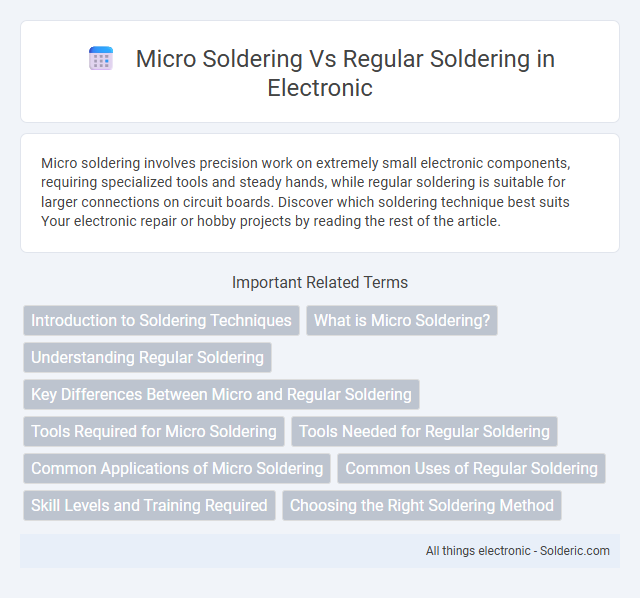Micro soldering involves precision work on extremely small electronic components, requiring specialized tools and steady hands, while regular soldering is suitable for larger connections on circuit boards. Discover which soldering technique best suits Your electronic repair or hobby projects by reading the rest of the article.
Comparison Table
| Aspect | Micro Soldering | Regular Soldering |
|---|---|---|
| Definition | Soldering of tiny components on PCBs, typically under 0.5mm pitch | Soldering of standard electronic components with larger pads and leads |
| Tools | Microscope, fine-tip soldering iron, precision tweezers | Standard soldering iron with broader tips |
| Applications | Smartphones, tablets, microelectronics repair | General electronics, wiring, circuit boards repair |
| Skill Level | Advanced; requires steady hands and experience | Beginner to intermediate; basic soldering knowledge sufficient |
| Component Size | Micro components (e.g., 0402, BGA, QFN packages) | Larger components (e.g., through-hole, DIP) |
| Precision | Very high precision required to avoid damage | Moderate precision sufficient |
| Cost | Higher due to specialized equipment and training | Lower; uses common tools and techniques |
| Time Consumption | Longer, detailed work | Faster for standard repairs |
Introduction to Soldering Techniques
Micro soldering involves precise work on tiny electronic components using specialized tools and magnification, ideal for repairing smartphones, laptops, and intricate circuit boards. Regular soldering uses standard soldering irons and is suited for larger components and general electronics assembly or repairs. Your choice should depend on the scale and complexity of the task to ensure accurate and effective results.
What is Micro Soldering?
Micro soldering is a precision technique used to repair or assemble very small electronic components, typically on circuit boards with fine-pitch connections. It involves the use of specialized tools such as microscopes, hot air rework stations, and ultra-fine soldering tips to handle components that are often smaller than 1 millimeter. Commonly applied in smartphone, laptop, and PCB repairs, micro soldering enables experts to fix issues like broken traces, detached components, and BGA chip replacements that regular soldering cannot address effectively.
Understanding Regular Soldering
Regular soldering involves joining electronic components using a soldering iron with temperatures typically ranging from 350degC to 400degC, suitable for larger circuit boards and wires. This process relies on melting a metal alloy to create a strong electrical and mechanical bond between components and PCB pads. Understanding regular soldering is essential before attempting micro soldering, as it provides foundational skills in handling solder, heat control, and component placement.
Key Differences Between Micro and Regular Soldering
Micro soldering involves working with extremely small components and fine-pitched connections, often requiring specialized tools such as microscopes and precision soldering irons. Regular soldering typically handles larger electronic parts and broader connections, making it suitable for general repairs and assembly without the need for magnification. Your choice between the two depends on the project's complexity, with micro soldering essential for intricate tasks like smartphone or circuit board repairs where precision is crucial.
Tools Required for Micro Soldering
Micro soldering demands precision tools such as a microscope, fine-tipped soldering iron, high-quality flux, and specialized solder wire with a smaller diameter compared to regular soldering. These tools enable you to work on tiny components and densely packed circuit boards typically found in smartphones and other delicate electronics. Proper tools are essential to achieve the accuracy and control micro soldering requires, making it significantly different from standard soldering setups.
Tools Needed for Regular Soldering
Regular soldering requires essential tools such as a soldering iron with adjustable temperature control, solder wire (commonly rosin-core), and a damp sponge or brass coil for tip cleaning. Additional items include tweezers for component handling, wire cutters, and flux to ensure proper solder flow. These tools support basic electronic assembly and repair tasks on larger components compared to the precision demanded in micro soldering.
Common Applications of Micro Soldering
Micro soldering is primarily used in electronics repair, including smartphones, tablets, and laptops, where precise connections on tiny components are essential. It enables repair of delicate parts such as integrated circuits, microchips, and circuit board traces that regular soldering tools cannot handle. This technique is crucial for reattaching broken pins, repairing damaged connectors, and modifying small electronic devices with high accuracy.
Common Uses of Regular Soldering
Regular soldering is commonly used in electronics repair, plumbing, and metalwork due to its ability to join larger components and pipes effectively. It is essential for circuit board assembly, wiring connections, and creating durable joints in metal objects. The process typically involves soldering temperatures between solder melting points of 180-250degC, suitable for tasks requiring moderate precision and strength.
Skill Levels and Training Required
Micro soldering demands a higher skill level and specialized training due to the precision required for working with tiny electronic components and densely packed circuit boards. Regular soldering typically involves larger components and simpler connections, making it accessible to beginners with basic soldering skills. Mastery in micro soldering often requires extensive practice and knowledge of microscopic techniques, while regular soldering can be learned more quickly through standard tutorials and hands-on experience.
Choosing the Right Soldering Method
Choosing the right soldering method depends on the precision and scale of your project, with micro soldering ideal for tiny components on circuit boards requiring meticulous accuracy and minimal heat exposure. Regular soldering suits larger, less intricate connections where speed and durability are prioritized over delicate handling. Your choice impacts the quality, reliability, and functionality of the final electronic assembly, making it crucial to match the method to your specific technical needs.
Micro soldering vs regular soldering Infographic

 solderic.com
solderic.com